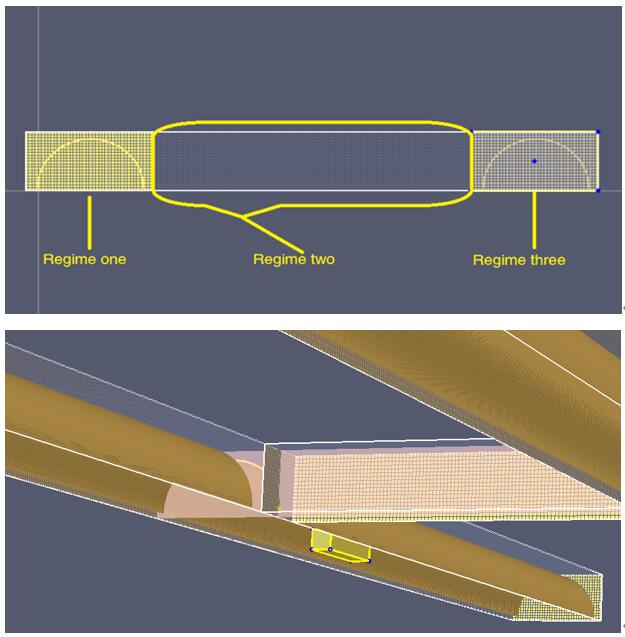Study on Fire Smoke Distribution and Smoke Control in Extra-long Double-hole Tunnel
Abstract
Abstract:
Construction of tunnels, as one of the main methods to solve physical traffic barriers, However, It vulnerable to the threat of fire during the process of tunnel operation period. In response to such situation, this article explores the smoke distribution of extra-long double-tube tunnel and its impact on evacuation in the event of a fire. This paper take the Jieling tunnel as an example, and applies Accident Tree Analysis (ATA) method combined with Fires Dynamics Simulator (FDS)simulation software to study the changes of harmful factors such as tunnel smoke. According to the research, when a fire occurs in an extra-long double-tube tunnel, It is concluded that people are supposed to be guided to leave via the nearest cross-passages as soon as possible, In the end analysis the roles that air curtains could play in the control of smoke. It is recommended to open the air curtain so that in such condition people away from the cross-passages have enough time to escape.
References
Brinckerhoff BP. (2005). Memorial tunnel fire ventilation test program. Comprehensive test report, Massachusetts Highway Department.
Cheong, M. K., Cheong, W. O., Lemaire, A. D., & Noordijk, L. M. (2014). Heat Release Rate of Heavy Goods Vehicle Fire in Tunnels with Fixed Water Based Fire-Fighting System. Fire Technology., 50(2), 249-266. https://doi.org/10.1007/s10694-013-0367-0
Chow, W. K., Gao, Y., Zhao, J. H., Dang, J. F., Chow, C. L., & Miao, L. (2015). Smoke movement in tilted tunnel fires with longitudinal ventilation. Fire Safety Journal., 75, 14-22. https://doi.org/10.1016/j.firesaf.2015.04.001
Elice-Cortes, J. C., Molina, N., Severino, A., Severino, G., Fuentes, A., & Rojas, P. (2020). Turbulent transport mechanisms on the heat confinement in tunnels by using low-velocity air curtains. Applied Thermal Engineering., 118, 115852. https://doi.org/10.1016/j.applthermaleng.2020.115852
GB/T3730.1 – 2001. (2001). Motor Vehicles and Trailers-Types-Terms and Definitions. National Technical Committee of Auto Standardization. (Chinese Standard)
Gehandler, J., Eymann, L., & Regeffe, M. (2015). Limit-Based Fire Hazard Model for Evaluating Tunnel Life Safety. Fire Technology., 51(3), 585-614. https://doi.org/10.1007/s10694-014-0406-5
Gu, X. C., Zhang, J. D., Pan, Y., Ni, Y.Q., Ma, C., Zhou, W., & Wang, Y. Y. (2020). Hazard analysis on tunnel hydrogen jet fire based on CFD simulation of temperature field and concentration field. Safety Science., 122, 104532. https://doi.org/10.1016/j.ssci.2019.104532
Gupta, S., Pavageau, M., & Elicer-Cortes, J. C. (2007). Cellular confinement of tunnel sections between two air curtains. Building and Environment., 4(29), 3352-3365. https://doi.org/10.1016/j.buildenv.2006.08.026
Harish, R., & Venkatasubbaiah, K. (2014). Effects of buoyancy induced roof ventilation systems for smoke removal in tunnel fires. Tunnelling and Underground Space Technology., 42, 195-205. https://doi.org/10.1016/j.tust.2014.03.007
Hitoshi, K., Yasushi, O., Hiroomi, S., & Osami, S. (2003). Fire properties in near field of square fire source with longitudinal ventilation in tunnels. Fire Safety Journal., 38, 319-340. https://doi.org/10.1016/S0379-7112(02)00089-9
Horikoshi, K. (2009). An Examination on Smoke Control by Means of Numerical Simulation in a Long Urban Tunnel[C]. 13th Road Engineering Association of Asia and Australasia Conference., Korea. https://doi.org/10.1177/1042391503013001002
Hu, X., Zhou, H. J., & Yang, F. (2019). Study on the Influence of Fire Smoke on the Design of Urban Rail Transit Safety Evacuation System. Henan ence and Technology.
JTG/T D70/2-02-2014. (2014). Detailed Rules of highway Tunnel Ventilation Design. China Communications Press Co., Ltd. (Chinese Standard)
Laurent, G., & Bertrand, G. (2018). Fault tree analysis and risk mitigation strategies for mine hoists. Safety Science., 110, 222-234. https://doi.org/10.1016/j.ssci.2018.08.010
Li, Y. Z., Lei, B., & Ingason, H. (2013). Theoretical and Experimental Study of Critical Velocity for Smoke Control in a Tunnel Cross-Passage. Fire Technology., 49(2), 435-449. https://doi.org/10.1007/s10694-010-0170-0
Li, Z. H. (2010). Toxic Mechanism and First Aid Measures of Common Harmful Combustion Products. Safety and Environmental Engineering., 017(003), 93-96, 101. https://doi.org/CNKI:SUN:KTAQ.0.2010-03-023 (in Chinese)
Lin, C. J., & Chuah, Y. K. (2008). A study on long tunnel smoke extraction strategies by numerical simulation. Tunnelling & Underground Space Technology Incorporating Trenchless Technology Research., 23(5), 522-530. https://doi.org/10.1016/j.tust.2007.09.003
Max, K., Daniel G., Philipp, G., Susanne, B., Mathias, M., Michael, J., Markus, N., Andreas, M., & Paul, P. (2015). The effect of dangerous goods transporters on hazard perception and evacuation behavior – A virtual reality experiment on tunnel emergencies. Fire Safety Journal., 78, 24-30. https://doi.org/10.1016/j.firesaf.2015.07.002
Mcgrattan, K. B., Mcdermott, R. J., Weinschenk, C. G., & Forney, G. P. (2013). Fire Dynamics Simulator, User's Guide. Nist Special Publication.
NFPA 502-2017. (2017). Standard for Road Tunnels, Bridges, and Other Limited Access Highways. America: US-NFPA.
PIARC Committee on Road Tunnels. (1999). Fire and Smoke Control in Road Tunnels. France: PIARC.
Sojoudi, A., Afshin, H., & Farhanieh, B. (2014). An analysis of carbone monoxide distribution in large tunnel fires. Journal of Mechanical ence & Technology., 28(5), 1917-1925. https://doi.org/10.1007/s12206-014-0339-4
Soufien, G., & Rejeb, B. M. (2017). CFD analysis of smoke blacklayering dispersion in tunnel fires with longitudinal ventilation. Fire and Materials., 41(6), 598-613. https://doi.org/10.1002/fam.2394
Vauquelin, O., & Telle, D. (2005). Definition and experimental evaluation of the smoke "confinement velocity" in tunnel fires. Fire Safety Journal., 40, 320-330. https://doi.org/10.1016/j.firesaf.2005.02.004
Xia, Y. X., Zhou, Y. D., & Wang, Y. D. (2009). Study on escape of people in highway tunnel fire. China Civil Engineering Journal., 8, 115-123. https://doi.org/CNKI:SUN:TMGC.0.2009-08-017 (in Chinese)
Xu, X. Y., Li, Y. Z., Xu, Z. Y., Li, Z. (2010). Control effect of smoke in different opening situations in a high-building stairwell. Journal of University of ence and Technology of China., 40(10), 1036-1042. https://doi.org/10.3969/j.issn.0253-2778.2010.10.008
Yong, A. L., Yang, G. S., & Peng, L. M. (2006). Research on the Mechanism of CO Hazards to Personnel in Tunnel Fire. Mining Technology., 006(003), 412-414. https://doi.org/10.13828/j.cnki.ckjs.2006.03.126 (in Chinese)
Zhuang, Y. H., Ding, H., Zheng, G. P., Cui, Y. K., & Huang, Y. (2020). Study on Ventilation System Linkage Control Strategy in a Double-Hole Tunnel Fire. Advances in Materials Science and Engineering., 5, 1-14. https://doi.org/10.1155/2020/5163632


This work is licensed under a Creative Commons Attribution 4.0 International License.
Copyright for this article is retained by the author(s), with first publication rights granted to the journal.
This is an open-access article distributed under the terms and conditions of the Creative Commons Attribution license (http://creativecommons.org/licenses/by/4.0/).








1.png)














